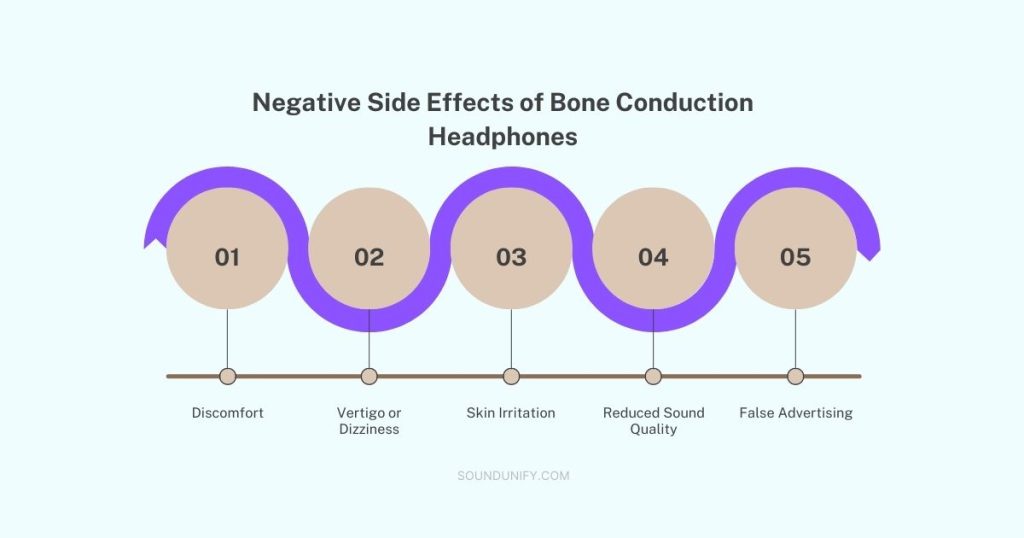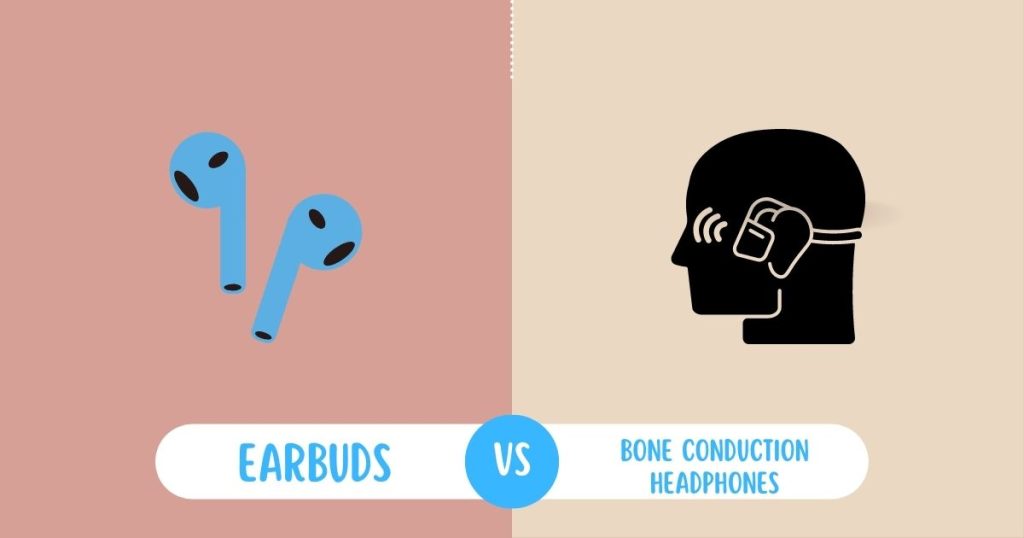Bone conduction headphones are generally safe to use. They offer a unique listening experience without damaging your eardrums. Now, you might wonder, "How is that even possible?" Well, I'm glad you asked.
Unlike traditional headphones, bone conduction headphones transmit sound waves through your skull directly to your inner ear.
This bypasses the eardrum entirely, a game-changer for those with hearing impairments or ear-related health issues. But it also raises a few questions. Are they truly safe? Could they potentially harm our skulls or brains?
As someone always curious about the latest tech, I’ve delved into the science behind these headphones and consulted with experts to get the answers.
So, stick around if you’re considering switching to bone conduction headphones or just curious about how they work. I promise it’s going to be an enlightening read!

8 Reasons Why Bone Conduction Headphones Safe
Safety might not be the first thing on your mind when enjoying your favorite tunes or podcasts. But with bone conduction headphones, you can have the best of both worlds – a great audio experience and peace of mind.
Let’s explore why these innovative headphones are safe for your audio needs.
1. Do Not Block Your Ears
One of the main reasons I find bone conduction headphones safe is that they don’t block your ears. This is a significant advantage over traditional headphones.
When I use traditional headphones, my ears are completely covered, which can lead to a build-up of earwax or even ear infections in some cases.
But with bone conduction headphones, my ears remain open, allowing air to circulate freely. This reduces the risk of ear-related health issues.
- Open Ears: With bone conduction headphones, your ears remain open, allowing you to hear ambient noise and reducing the risk of ear-related health issues.
- Air Circulation: The open design allows air to circulate freely, which can help prevent the build-up of earwax and reduce the risk of ear infections.
2. Do Not Cause Hearing Damage
Another reason why bone conduction headphones are safe is that they don’t cause hearing damage. Traditional headphones deliver sound directly into the ear canal, potentially damaging the eardrum if the volume is too high.
However, bone conduction headphones work differently. They send vibrations through the bones of the skull directly to the inner ear. This bypasses the eardrum, reducing the risk of hearing damage.
| Traditional Headphones | Bone Conduction Headphones |
|---|---|
| Deliver sound directly into the ear canal | Send vibrations through the bones of the skull |
| It can potentially damage the eardrum if the volume is too high | Bypass the eardrum, reducing the risk of hearing damage |
3. Safe to Wear During Outdoor Activities
I enjoy outdoor activities and find bone conduction headphones exceptionally safe. Because they don’t block your ears, you can listen to music or take a call while being aware of your surroundings.
This is crucial for safety, especially when running, cycling, or hiking. You can hear traffic, other people, and potential hazards, which isn’t possible with traditional headphones.
- Awareness of Surroundings: Bone conduction headphones allow you to hear ambient noise, increasing safety during outdoor activities.
- Hear Potential Hazards: Hearing traffic, other people, and potential hazards can be a lifesaver, especially when running, cycling, or hiking.
| Traditional Headphones | Bone Conduction Headphones |
|---|---|
| Block your ears, reducing awareness of your surroundings | Do not block your ears, allowing you to hear ambient noise |
| It can be unsafe during outdoor activities due to reduced awareness | Safe for outdoor activities due to increased awareness |
4. Beneficial for Those Who Are Hard of Hearing
Bone conduction headphones can be particularly beneficial for those who are hard of hearing. Traditional headphones rely on air conduction to deliver sound through the ear canal to the eardrum.
However, any blockage or damage in the ear canal or eardrum can hinder sound transmission, making it difficult for people with hearing impairments to use these headphones.
On the other hand, bone conduction headphones bypass the ear canal and eardrum altogether. They deliver sound through vibrations sent directly to the inner ear through the skull’s bones.
This can be particularly beneficial for those with conductive hearing loss, a hearing loss where sound is blocked in the ear canal or middle ear.
- Bypasses the Ear Canal and Eardrum: Bone conduction headphones deliver sound through vibrations sent directly to the inner ear, bypassing the ear canal and eardrum. This can be particularly beneficial for those with conductive hearing loss.
- Allows for Normal Conversation: Since these headphones do not block the ear canal, they allow for normal conversation while being used. This can be particularly useful for those with hearing impairments who may need to communicate with others while using their headphones.
5. Enhanced Situational Awareness
| Traditional Headphones | Bone Conduction Headphones |
|---|---|
| Block your ears, reducing awareness of your surroundings | Do not block your ears, allowing you to hear ambient noise |
| It can be unsafe during outdoor activities due to reduced awareness | Safe for outdoor activities due to increased awareness |
Bone conduction headphones enhance situational awareness by allowing you to hear ambient noise.
This is particularly important for safety during outdoor activities like running, cycling, or hiking.
You can hear traffic, other people, and potential hazards, which isn’t possible with traditional headphones.
6. Comfortable to Wear
In my experience, bone conduction headphones are comfortable to wear. Unlike traditional headphones that can cause discomfort when worn for extended periods, bone conduction headphones sit on your cheekbones, not in or over your ears.
This design reduces the pressure on your ears, making them comfortable for long periods. Plus, they’re typically lightweight and designed to stay in place during physical activity, adding to their comfort.
7. Open-Ear Design
One of the standout features of bone conduction headphones is their open-ear design. Unlike traditional headphones that fit in or over your ears, bone conduction headphones rest on your cheekbones. This design leaves your ears open, allowing you to hear ambient noise.
From my experience, this open-ear design has several benefits:
- Enhanced Situational Awareness: Because your ears aren’t blocked, you can listen to music or take a call while being aware of your surroundings. This is particularly beneficial outdoors, where hearing ambient noise can enhance your safety.
- Reduced Risk of Ear Infections: Traditional headphones, especially in-ear models, can increase the risk of ear infections. However, this risk is significantly reduced since bone conduction headphones don’t enter your ears.
- No Discomfort from Prolonged Use: Traditional headphones can sometimes cause discomfort or pain when used for extended periods. This isn’t an issue with the open-ear design of bone conduction headphones.
8. Affordable
Another reason why bone conduction headphones are a great choice is their affordability.
While prices vary depending on the brand and specific model, you can find a quality pair of bone conduction headphones that won’t break the bank.
This makes them a cost-effective alternative to traditional headphones, especially considering their unique benefits.
Negative Side Effects of Bone Conduction Headphones

While bone conduction headphones offer many benefits, it’s also important to consider potential drawbacks. Here are some of the negative side effects that some users have reported:
1. Discomfort
Some users have reported discomfort when using bone conduction headphones. This is often due to the pressure applied to the cheekbones where the headphones rest.
While this discomfort is usually minor and can often be alleviated by adjusting the fit of the headphones, it’s something to be aware of.
2. Vertigo or Dizziness
In rare cases, some users have reported experiencing vertigo or dizziness when using bone conduction headphones. This is likely due to the vibrations sent through the bones of the skull to the inner ear.
If you’re prone to vertigo or dizziness, it’s worth consulting with a healthcare professional before using bone conduction headphones.
3. Skin Irritation
Skin irritation can occur with any headphones; bone conduction headphones are no exception. This is often due to the materials used in the headphones or a reaction to sweat and heat.
If you have sensitive skin, it’s worth looking for bone conduction headphones made with hypoallergenic materials.
4. Reduced Sound Quality
While bone conduction headphones provide a unique listening experience, some users find that the sound quality isn’t as high as that of traditional headphones.
Bone conduction headphones bypass the eardrum, designed to interpret sound waves accurately. As a result, some sounds, particularly higher frequencies, may not be as clear or crisp.
5. False Advertising
Finally, it’s important to be aware of false advertising when purchasing bone conduction headphones.
Some manufacturers may exaggerate the benefits or performance of their products. Always do your research and read reviews before making a purchase.
Are Bone Conduction Headphones Better for Your Ears Than Earbuds?

Yes, bone conduction headphones can be better for your ears than earbuds. This is due to several reasons that I’ll explain below.
However, it’s important to remember that everyone’s needs and preferences differ, and what works best for one person might not work well for another.
Let’s compare bone conduction headphones and earbuds across seven key aspects:
1. Hearing Damage
Bone conduction headphones deliver sound through vibrations sent directly to the inner ear, bypassing the ear canal and eardrum.
This reduces the risk of hearing damage, which can occur with traditional earbuds if the volume is too high or if they’re used for prolonged periods.
In contrast, earbuds deliver sound directly into the ear canal, which can potentially damage the eardrum if the volume is too high.
2. Ear Infections
Earbuds, especially in-ear models, can increase the risk of ear infections due to the build-up of earwax and bacteria. This risk is significantly reduced since bone conduction headphones don’t enter your ears.
The open design of bone conduction headphones allows air to circulate freely, which can help prevent the build-up of earwax and reduce the risk of ear infections.
3. Situational Awareness
Bone conduction headphones allow you to hear ambient noise, which isn’t possible with traditional earbuds.
This can enhance your safety, especially during outdoor activities where being aware of your surroundings is crucial.
With earbuds, your ears are completely covered, limiting your ability to hear ambient noise and potentially putting your safety at risk during outdoor activities.
4. Comfort
Some people find bone conduction headphones more comfortable than earbuds, especially for extended periods. This is because they rest on your cheekbones, not in or over your ears.
On the other hand, earbuds can cause discomfort when worn for extended periods.
5. Sound Quality
While bone conduction headphones provide a unique listening experience, some users find that the sound quality isn’t as high as that of traditional earbuds.
This is because bone conduction headphones bypass the eardrum, which is designed to interpret sound waves accurately.
On the other hand, earbuds deliver sound directly into the ear canal, which can provide a more immersive listening experience.
6. Ease of Use
Both bone conduction headphones and earbuds are generally easy to use. However, some might initially find bone conduction headphones less intuitive due to their unique design.
On the other hand, earbuds have a more familiar design and are generally easy to use right out of the box.
7. Price
The price of both bone conduction headphones and earbuds can vary widely depending on the brand and model. You can generally find quality options in both categories that fit various budgets.
It’s always important to research and read reviews before purchasing to ensure you get good value.
| Aspect | Bone Conduction Headphones | Earbuds |
|---|---|---|
| Hearing Damage | Deliver sound through vibrations sent directly to the inner ear, reducing the risk of hearing damage. | Deliver sound directly into the ear canal, potentially damaging the eardrum if the volume is too high. |
| Ear Infections | Do not go in your ears, reducing the risk of ear infections due to the build-up of earwax and bacteria. | It can increase the risk of ear infections due to the build-up of earwax and bacteria, especially in-ear models. |
| Situational Awareness | Allow you to hear ambient noise, enhancing safety during outdoor activities. | Completely cover your ears, potentially limiting your ability to hear ambient noise and putting your safety at risk during outdoor activities. |
| Comfort | Rest on your cheekbones, not in or over your ears, making them more comfortable for some people, especially for extended periods. | It can cause discomfort when worn for extended periods, especially in-ear models. |
| Sound Quality | Bypass the eardrum, which can lower sound quality for some users. | Deliver sound directly into the ear canal, providing a more immersive listening experience. |
| Ease of Use | It may be less intuitive for some people due to their unique design. | They are a more familiar design and are generally easy to use right out of the box. |
| Price | It can vary widely depending on the brand and model, but quality options that fit various budgets are available. | It can also vary widely in price, but quality options that fit various budgets are available, like bone conduction headphones. |
Do Bone Conduction Headphones Cause Cancer?
No, bone conduction headphones do not cause cancer.
This statement is based on the current scientific literature and research available. No scientific evidence or research studies suggest a link between bone conduction headphones and cancer development.
Cancer is caused by changes (mutations) in the DNA within cells, which can cause the cells to grow out of control and form a tumor.
These changes are often the result of a complex mix of genetic and environmental factors rather than a single cause, such as the use of a specific type of headphones.
It’s important to note that bone conduction headphones send sound vibrations through the bones of the skull and jaw directly to the inner ear, bypassing the eardrum and outer ear.
This is a different method of sound delivery compared to traditional headphones or earbuds, which transmit sound waves through the air into the ear canal.
While this method of sound delivery is different, it does not involve the emission of radiation or other known carcinogenic (cancer-causing) agents.
Therefore, there is no reason to believe that bone conduction headphones would increase the risk of developing cancer.
However, like any product, it’s always important to use bone conduction headphones as directed by the manufacturer and to maintain a healthy level of skepticism about any claims that seem too good to be true.
If you have concerns about your health and safety while using these headphones, I recommend discussing them with a healthcare professional.
Are Bone Conduction Headphones Safe for Tinnitus?
Yes, bone conduction headphones are safe for individuals with tinnitus.
Tinnitus is characterized by the perception of noise or ringing in the ears. It’s a common problem that affects about 15 to 20 percent of people and is especially prevalent among those with hearing loss.
Bone conduction headphones can be a good choice for individuals with tinnitus for several reasons:
- They do not exacerbate the condition: Unlike traditional headphones that deliver sound directly into the ear canal, bone conduction headphones transmit sound through the bones of the skull and jaw directly to the inner ear. This bypasses the outer and middle ear, where many common causes of tinnitus occur, such as earwax blockage or changes in the ear bones.
- They allow for ambient noise: Bone conduction headphones do not block the ear canal, allowing users to hear ambient sounds. This can help mask the ringing or buzzing sounds characteristic of tinnitus, relieving those affected.
- They can be used with hearing aids: Many people with tinnitus use them to help manage their symptoms. Bone conduction headphones can be used with most hearing aids, making them a versatile option for those with hearing loss and tinnitus.
A study titled “Hearing Rehabilitation through Bone-Conducted Sound Stimulation: Preliminary Results” found that participants with hearing loss, including those with tinnitus, benefited from using bone conduction devices.
The study reported that 80% of the participants experienced decreased tinnitus severity after using a bone conduction device.
However, it’s important to note that while bone conduction headphones can be a safe and effective tool for individuals with tinnitus, they are not a cure for the condition.
If you have tinnitus and are considering trying bone conduction headphones, I recommend discussing this with a healthcare professional or an audiologist. They can provide personalized advice based on your specific condition and needs.
Are Bone Conduction Headphones Safe for Cycling?

Yes, bone conduction headphones are safe for cycling.
When it comes to cycling, safety is paramount. One of the key aspects of staying safe while cycling is maintaining awareness of your surroundings. This includes hearing traffic, pedestrians, and other potential hazards.
This is where bone conduction headphones come in. Unlike traditional headphones or earbuds, bone conduction headphones do not cover or block the ear canal. Instead, they transmit sound through the bones of the skull and jaw directly to the inner ear.
This leaves your ear canals open, allowing you to hear ambient noise and maintain awareness of your surroundings.
Here are a few reasons why bone conduction headphones are a safe choice for cycling:
- Situational Awareness: Bone conduction headphones allow you to listen to music or take calls without blocking your ears. This means you can still hear traffic, pedestrians, and other potential hazards, making your ride safer.
- Comfort and Stability: Bone conduction headphones are designed to be worn over the ear and rest on your cheekbones. This design is comfortable for long rides and ensures the headphones stay in place, even during vigorous cycling.
- No Noise Isolation: Traditional headphones often feature noise isolation or cancellation, which can be dangerous when cycling as they block out important environmental sounds. Bone conduction headphones do not have this feature, making them a safer option.
- Legal Compliance: In some regions, it’s illegal to ride a bicycle with both ears covered. Since bone conduction headphones do not cover the ears, they comply with these laws.
FAQs
1. Are bone conduction headphones safe?
Yes, bone conduction headphones are considered safe. They transmit sound through the bones in your skull, bypassing the eardrum and reducing the risk of eardrum damage. They also allow ambient noise, enhancing your safety if you’re using them while walking or cycling.
2. Are bone conduction headphones OSHA-approved?
OSHA (Occupational Safety and Health Administration) does not specifically approve or disapprove of specific headphone models, including bone conduction headphones.
However, OSHA does have guidelines about noise exposure in the workplace. If you’re considering using bone conduction headphones in a work environment, it’s best to consult with your employer or a safety officer.
3. Are bone conduction headphones safe for your brain?
Yes, bone conduction headphones are safe for your brain. They work by transmitting sound vibrations through the bones of the skull directly to the inner ear, bypassing the eardrum. This process does not involve any form of radiation or other known harmful effects on the brain.
4. Do bone conduction headphones work for people with hearing loss?
Yes, bone conduction headphones can benefit people with certain types of hearing loss, particularly conductive hearing loss. This is because they bypass the outer and middle ear and deliver sound directly to the inner ear.
Final Thoughts
After diving deep into the world of bone conduction headphones, I’m convinced they’re a safe and innovative option for listening to music or taking calls.
They offer a unique blend of safety, comfort, and functionality. From reducing the risk of hearing damage to enhancing situational awareness, these headphones truly stand out. Whether you’re cycling, working, or just relaxing, they’re a game-changer.
So, if you’re up for a new audio experience, why not try bone conduction headphones? You might find your new favorite gadget!
James Dimento is a Chief-in-Editor of SoundUnify. He is a headphone enthusiast and creative writer passionate about audio technology. He has three years of experience writing about headphones and sound quality and is responsible for creating reviews and taking care of all administration.
